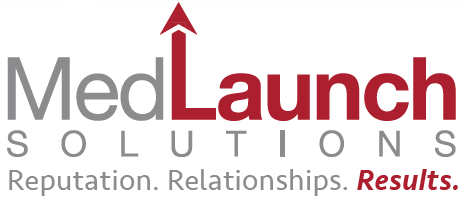MARKETING IN A CRISIS: Medical practice marketing strategies for COVID19

Medical marketing gurus Ashley Ulrich and Dr. Rick Thompson examine strategies for medical practices to get through these unprecedented times.
COVID19 is bringing fear and uncertainty into our communities, leaving many medical practices questioning what lies ahead. Although you may need to adjust some of your healthcare marketing efforts, cutting marketing when things get tight is the wrong decision. Continuing to build brand awareness and cultivating and maintaining your referral network are ongoing, no matter what. In addition, people are spending more time than ever online and many referring medical providers and their staff have more time on their hands. It is essential to stay top-of-mind and take advantage of the opportunity to ethically and effectively position for medical practice or facility for the future.

Let’s first think about fundamental ways to market a medical practice or facilities:
- Branding
- Digital marketing/social media
- Traditional Advertising
- Referral Marketing
- Media/Public Relations
- Reputation Management
All of these strategies are important on some level to medical practices of all shapes and sizes. Marketing is as important as ever as medical practices must rethink existing, and evaluate new, strategies to grow in a world that is much different today than it was a few months ago. Nearly 50% of patients or a family member have skipped or postponed treatment because of COVID-19 and will eventually need to schedule appointments, either virtually or in person. Staying top-of-mind with patients and referral sources with any or all of the above fundamental marketing strategies, with a consistent and frequent message, is essential. Here are some things to consider as you think about keeping your medical practice thriving during these challenging times:
1. Don’t. Stop. Marketing.
The last thing you want to do is halt marketing efforts. Building and maintaining your brand is the way your patients and potential patients will maintain their recognition and trust in you as a practice. They need to know that you are here and you are weathering the storm. You should also use this time to capitalize on exposure. Many practices first action has been to cut marketing expenditures. This allows you the space, time and audience to maximize impact and impression on potential patients and referral sources.
Right now is a great time to try something new. Be bold in your marketing efforts. The most successful practices will leverage opportunities presented during these challenging times and cultivate brand awareness needed to support their businesses into the future.
2. Stay engaged with referral partners
Utilizing a Physician Liaison, a representative that can help build these referral relationships on your behalf, is essential in a competitive marketing. Other doctors, nurses and patients have choices, and referral habits can change. Staying top-of-mind and cultivating and maintaining trust and rapport in your community is one of the best long-term marketing strategies out there for medical practices.
3. Embrace high-value social media
Social media, especially Facebook (for the sheer volume of users), is an important channel to keep you top-of-mind in your community. It serves to build your authority further in the eyes of current and potential patients – they get to know you and trust you. Focusing your message on your commitment to the health and safety of your community will continue to reconfirm your value to them. Your patients may be rescheduling appointments now, but eventually, they’ll need to come back in. And when they do, your continued educational efforts will make them more likely to come to you for their long-awaited procedures. This is nurture marketing and it’s incredibly effective for healthcare providers.
Lastly, and very importantly, don’t outsource your medical social media to a general firm. Use a medically-specific healthcare marketing firm and keep your sights set on providing the best patient care possible. Having the added hurdle of a marketing partner with a learning curve about the topics that matter to your patients, slows down your practice at a time when reaction time is critical.
4. Seek ways to be visible in your community.
This is a great time to build goodwill in your community. Patients want to go to a practice that they see contributing to the community around them. Referring physicians and their nursing staff want to see you active in the community, perhaps by donating time, food, money or volunteer hours. Writing a column in a local new publication or doing a brief interview on a local TV station are also great and effective ways for an exposure opportunity for your practice.
We also always stress the importance of joining the local Chamber of Commerce with our clients. Getting involved in chamber events or hosting (when safe to do so) events at your practice for other businesses to see how things are going. Anything to build awareness of your practice and providers within your community is a great way to stay top-of-mind!
5. Plan for the long term
There are indeed doctors that understand the business side of their medical practice and make it a priority. They understand marketing and the importance of a robust referral network and planning for the future. But for each doctor that gets it, there are many more that don’t or don’t want to, much of which is due to the lack of business education in medical school. Patients should certainly be doctors’ primary priority; however, it is essential for physicians to understand their practice as a business in order for it to grow and thrive in the long term. Clinical expertise is simply not enough. Implementing key marketing strategies to attract new referral sources and patients is crucial.
6. Trust the advice of experts
Knowing how to best promote your practice to patients and other medical providers is a big task. Less than 10% of physicians routinely refer to physicians they don’t know and about 40% say they know something specific about the specialists’ outcomes or quality records. The more well-known you are in your community, the greater your opportunity for referrals from other medical providers (namely PCPs). No time for this? Hire a Physician Liaison to make connections on your behalf. This is a very effective model that has shown time and time again to help specialty practices build patient pipelines that ensure long term success.
7. Stay Tuned into Your Practice Reputation Management
Staying on top of reviews (both negative AND positive) and responding immediately is essential. Asking satisfied patients for feedback and/or surveying patients after visits are also both very effective to build and maintain trust and rapport.
8. Update your Medical Practice Local Online Listings
9. Blog
In regards to relationship marketing for referrals, blogs give referring medical providers a chance to get to know you, the scope of your practice, your expertise and your passions. The more they get to know you, they more they trust you. The more they trust you, the more comfortable they are sending their patients to you. Your blog is a platform that you can personally customize to help other physicians get to know more about you and your specialty. Short, newsy pieces with clinical information that PCPs can use are a great way to win points. Think carefully about what your referral sources need to know. Then give it to them in brief. Post to your website and social media sites and invite referring medical providers to follow it. Again, a Physician Liaison can help with this.
When starting a blog, we suggest committing to a schedule. Frequency and consistency are important for building brand awareness, but are also great ways to continue to regularly improve SEO.
Who do you think will be in a stronger positon when the crisis lifts – a medical practice that has stopped or limited marketing efforts during the crisis? Or one that’s been consistently engaging and informing their patients and referral sources? Marketing during challenging times builds patient and referrer confidence in your practice and providers and keeps you top-of-mind. And, when other practices cut marketing budgets and go quiet, this creates a huge opportunity for the ones still connecting with their communities to rapidly grow brand loyalty, awareness and
help keep you in front of patients who need immediate care, as well as those who will eventually pick up the phone to make an appointment to see you.
We look forward to helping medical practices get through this challenging season and prepare for better times ahead. Stay healthy!
Medical Practice Marketing eBook
Download this free guide to discover how to grow your practice with some MedLaunch specific tips and steps that have worked for our clients.
Fill out the form today to receive your free copy.
